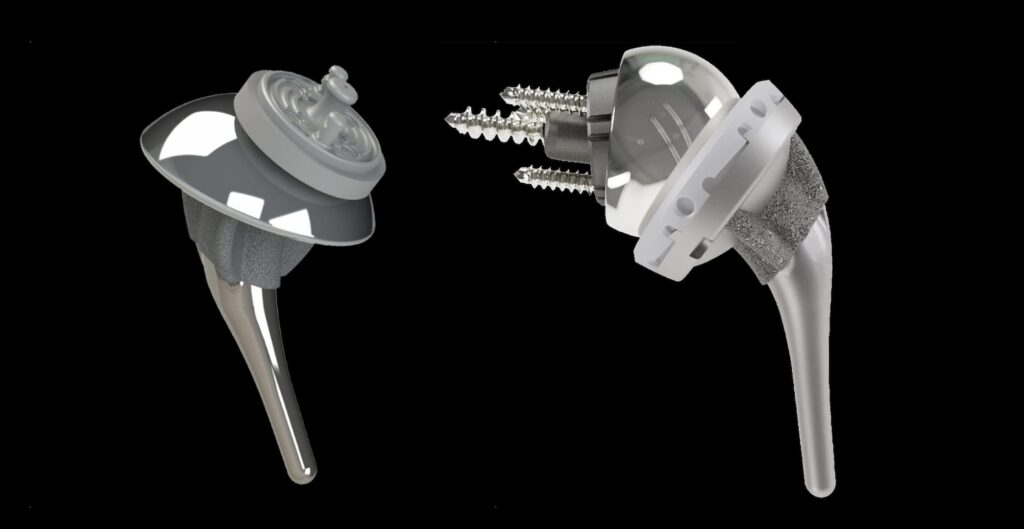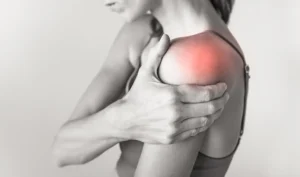How common is shoulder replacement surgery? Statistics report that over 53,000 Americans undergo this procedure annually, making it a significant practice in contemporary orthopedics. This post examines the trends contributing to this number and what patients need to know about the surgery’s role, types, and outcomes in managing shoulder conditions.
Key Takeaways
- Shoulder replacement surgeries are increasingly popular, with estimates suggesting a potential rise to between 174,810 and 350,558 procedures annually by 2025, driven by an aging population and advancements in surgical techniques and materials.
- There are various types of shoulder replacement surgeries including total and reverse, each indicated for specific conditions such as rotator cuff tears or arthritis, with reverse shoulder arthroplasty showing a particularly high satisfaction and function improvement over a decade post-surgery.
- Alternatives to shoulder replacement surgery, including medications, physical therapy, and minimally invasive procedures like shoulder arthroscopy, can provide symptom management and improve quality of life; however, the longevity of successful results post-surgery often necessitates a structured recovery and rehabilitation program.
Prevalence of Shoulder Replacement Surgery
Shoulder replacement surgery may not be as widely discussed as knee or hip replacement, but it is equally effective in alleviating joint pain. In fact, every year, approximately 53,000 people in the U.S. undergo some form of shoulder replacement surgery, a testament to its growing popularity in the world of orthopedic procedures.
Though shoulder replacement surgeries may seem less frequent compared to hip or knee replacements, their impact is nonetheless significant. For those contending with chronic shoulder pain, undergoing shoulder surgery, such as these procedures, is nothing short of life-altering, enabling them to embark on a journey towards pain-free mobility and improved quality of life.
Factors Driving Demand
What factors are driving the demand for shoulder replacement surgeries? A significant force is the aging population. As we age, our joints naturally degrade, leading to conditions like arthritis that often necessitate surgical interventions like shoulder replacement.
In addition, advancements in shoulder implant technology have played an enormous role. With continuous enhancements in surgical techniques and prosthetic design, success rates have continued to increase, bolstering the overall demand for this type of surgery.
These advancements have improved the lifespan of implants, offering patients a long-term solution to their shoulder woes.
Types of Shoulder Replacement Surgeries
Like the individuality of patients, the types of shoulder replacement surgeries also vary. The procedures can be broadly categorized into total shoulder replacement and reverse shoulder replacement.
In an anatomic total shoulder replacement, a shoulder joint replacement surgery, arthritic joint surfaces are replaced with a metal ball and plastic socket, mimicking the natural ball and socket joint. This can be either cemented or press fit into the bone, depending on the specific requirements of the patient.

Then there’s the reverse shoulder replacement surgery. In this procedure:
- The positions of the metal ball and plastic socket are switched
- This allows the deltoid muscle to be used instead of a torn rotator cuff
- This is a distinct difference from the conventional total shoulder replacement method.
Success Rates and Outcomes
How effective are these surgeries? The answer is quite well. Most patients experience significant pain relief and an improved range of motion in the affected shoulder after shoulder replacement surgery.
Then there’s the reverse shoulder replacement surgery. In this procedure:
- The positions of the metal ball and plastic socket are switched
- This allows the deltoid muscle to be used instead of a torn rotator cuff
- This is a distinct difference from the conventional total shoulder replacement method.
are known risk factors for shoulder replacement surgery.
Serious conditions such as severe fractures and difficulty in putting bone pieces back in place, as well as an interrupted blood supply to bone pieces, commonly necessitate shoulder replacements. Conditions like post-traumatic arthritis, which is the degradation of articular cartilage due to serious shoulder injury, can lead to the need for shoulder replacement. Rheumatoid arthritis and avascular necrosis, both painful conditions, frequently lead to arthritis and the requirement for shoulder replacement surgery involving the upper arm bone.
Additionally, lifestyle factors like tobacco use can heighten the risk of complications and interfere with healing after shoulder replacement surgery.
Gender Differences
As for gender differences, existing research is currently limited. There isn’t specific data concerning the prevalence of shoulder replacement surgery or the outcomes post-surgery based on gender. However, as research continues, we may soon have a clearer picture of how gender influences the need for and outcomes of shoulder replacement surgeries.
Alternatives to Shoulder Replacement Surgery
Certainly, shoulder replacement surgery isn’t the sole remedy for shoulder pain or dysfunction. There are viable alternatives available, particularly for those who aren’t ready or don’t require a full joint replacement. These alternatives range from non-surgical treatments, such as medications and physical therapy, to minimally invasive procedures like shoulder arthroscopy.
While these alternatives may not offer a permanent solution, they can be effective in managing symptoms and improving quality of life. But it’s important to remember that the best treatment option depends on a variety of factors, including:
- the patient’s age
- medical history
- lifestyle
- the severity of their condition.
Non-Surgical Treatments
Various shoulder conditions can be treated using non-surgical options that include:
- Medications, such as over-the-counter pain relievers and anti-inflammatory drugs, prescription-strength oral steroids, non-narcotic pain relievers, and topical ointments
- Injections
- Physical therapy
- PRP
Specialized physical therapists use exercises to:
- Strengthen shoulder muscles
- Alleviate pain
- Restore movement
- Reduce the likelihood of future injury
Activity modification advised by specialists can help manage pain and prevent re-injury, while braces and supports may be used to immobilize the shoulder during recovery.
Minimally Invasive Procedures
Shoulder arthroscopy, especially for conditions involving muscles, tendons, and ligaments, is a widely chosen alternative intervention for shoulder conditions. This minimally invasive procedure typically requires under an hour and is performed while the patient is in a semi-seated or side-lying position.
During shoulder arthroscopy, the following steps are typically followed:
- Small incisions are made to allow for the insertion of a tiny camera and specialized instruments.
- The joint is inflated with fluid to enhance visibility.
- Nerve blocks are often utilized for pain management.
- After the procedure, patients are allowed to go home the same day but are required to rest at the hospital for a short period of time for recovery.
Recovery and Rehabilitation
Optimal results post shoulder replacement surgery heavily rely on recovery and rehabilitation. Following surgery, patients will experience pain and swelling, which generally subsides within the first few days. Physical therapy begins shortly after, with the utilization of a sling for immobilization.
A well-structured rehabilitation program is crucial to achieving optimal results from shoulder replacement surgery, making extensive and proper postoperative rehabilitation a key factor in the surgery’s success. Early rehabilitation includes gentle therapy exercises starting within the first two weeks, with a home exercise program designed to strengthen and improve the flexibility of the shoulder.
Post-Surgery Care
The recovery process greatly depends on post-surgery care. Immediately after the operation, a preoperative interscalene nerve block is used for initial pain relief, lasting 24 to 72 hours. Post-surgery pain management may include scheduled acetaminophen and ‘as-needed’ narcotic pain medication.
Applying ice to the shoulder can help manage pain during the first few weeks following surgery. Shoulder braces and slings are utilized post-surgery to support and protect the joint, aid in recovery, and help manage pain.
Physical Therapy and Exercise
The role of physical therapy and exercise is central to the recovery process. After total shoulder replacement, physical therapy generally progresses from gentle range of motion to active strengthening, and ends with functional training exercises.
Initial exercises after surgery typically include pendulum exercises, crawl exercises to extend shoulder mobility, and assisted external rotation movements, progressing towards more advanced exercises like shoulder blade squeezes and overhead stretches.
Consistent exercising post-surgery is essential, with specialists often advising 10 to 15 minutes of exercise, 2 or 3 times a day during the initial recovery period to alleviate stiffness and pain.
Long-Term Outcomes and Revision Surgery
Most patients report less pain and improved function, making the long-term outcomes of shoulder replacement surgery generally positive. However, in some cases, the surgery may not achieve full restoration of joint movement and strength, leading in certain instances to the need for additional surgery.
Due to complications or implant wear, some patients might need revision surgery. This can be due to a variety of factors such as:
- the wearing out of the artificial joint
- infection
- dislocation
- fracture around the implant
Lifespan of Implants
Shoulder replacement implants typically have a good lifespan, with around 90% of them lasting beyond 10 years. The estimated 10-year survival rate for total shoulder replacements stands at 94.6%, while humeral hemiarthroplasties have a survival rate of 90.4%, showing a generally good long-term implant survival.
Revision Surgery
In instances of implant wear, infection, dislocation, or fracture around the implant, revision surgery might be required. Such complications can prompt revision surgery, which might include:
- Implant loosening
- Rotator cuff failure
- Nerve damage
- Dislocation
- Fracture of the surrounding bones
- Blood clots
- Infection
Although these complications present challenges, most patients have a good recovery from revision shoulder replacement surgery. The new implants generally function effectively, offering patients renewed mobility and an improved quality of life.
Summary
Shoulder replacement surgery has emerged as a powerful solution for those grappling with persistent shoulder pain and dysfunction. From understanding the prevalence and factors driving its demand, to exploring the various types of surgeries, risk factors, alternatives, and post-surgery care, it’s clear that this procedure offers a promising path to pain relief and improved mobility. It’s a journey of transformation, not just of the shoulder, but of the lives it touches, offering a renewed chance at reclaiming life’s simple joys, one movement at a time.




